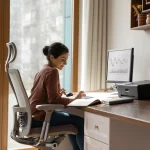How to Select the Perfect Ergonomic Office Chair for Your Needs

Whether you’re working in a bustling office environment or from the comfort of your home, the right office chair can significantly impact your productivity and comfort. A well-designed ergonomic office chair not only promotes proper posture but also helps alleviate fatigue, reduces the risk of musculoskeletal disorders, and enhances your overall well-being.
Setting up an ergonomic workspace begins with selecting the right chair—one that conforms to your body, aligns your spine, and meets the demands of prolonged working hours. In this article, we will highlight the essential features to consider when choosing an ergonomic chair and discuss the growing popularity of modular desk chairs and stools in today’s adaptable work environments.
Key Features to Look for in an Ergonomic Office Chair
Adjustability
The cornerstone of an effective ergonomic chair is its adjustability. Every individual has different requirements based on their height, weight, posture, and work habits. Therefore, an adjustable office chair—featuring customizable armrests, tilt tension, backrest angle, and seat height—is crucial for ensuring comfort and support.
Look for chairs that offer the following:
- Seat height adjustment to keep your feet flat on the ground
- Lumbar support adjustment to provide proper back support
- Armrest positioning to relieve strain on your shoulders and wrists
- Recline functionality to relieve pressure on your spine during breaks
These features combine to enhance comfort and support throughout the day.
Lumbar Support
Proper lumbar support is one of the most critical features in any ergonomic chair. This component supports the natural inward curve of the lower spine, helping to prevent slouching and reduce stress on the lower back.
An adjustable lumbar system guarantees a personalized fit, offering long-term comfort and promoting healthy posture, especially during extended work sessions.
Seat Height
The seat height is essential for aligning your knees with your hips, which ensures better circulation and overall comfort. A seat height adjustment range of 16 to 21 inches from the floor is ideal for most users.
When your feet are flat on the floor and your thighs are parallel to it, you reduce the risk of lower-body fatigue and maintain a neutral sitting posture.
Seat Depth and Width
The right seat depth allows you to sit back comfortably while keeping a 2–4 inch gap between the back of your knees and the edge of the chair. Proper seat width and depth ensure that you get adequate support without restricting blood flow.
The standard seat width of 17 to 20 inches is suitable for most individuals, while deeper seats or models with adjustable depth are perfect for taller people or those needing more thigh support.
Backrest Design
The backrest of an ergonomic chair should mirror the natural curve of the spine and support your back from the lumbar region to your shoulders. Curved or S-shaped backrests offer full spinal alignment, while height-adjustable and reclining backrests provide flexibility to shift posture and move throughout the day.
Choose a backrest that combines both support and flexibility to provide comfort during work and relaxation breaks.
Exploring Modular Desk Chairs and Stools
Modular Desk Chair
Modular desk chairs are an excellent choice for offices that prioritize customization and adaptability. These chairs allow users to select from different seat cushions, backrests, and armrests to create a setup that perfectly suits their body type and work style.
These chairs are ideal for dynamic work environments where flexibility is key and where seating must accommodate a variety of needs or be easily adjusted for different users.
Stools Chair
The stools chair is becoming increasingly popular in modern workplaces, especially in settings where mobility and active sitting are emphasized. Stools promote movement, support posture changes, and are well-suited for use with standing desks, making them a great choice for creative studios, laboratories, and collaborative workspaces.
These chairs are also beneficial for reducing sedentary behavior, engaging muscles, and complementing your overall ergonomic workstation setup.
Integrating Ergonomic Chairs into Your Workspace
Now that you’re familiar with what to look for in an ergonomic chair, how do you put this knowledge into practice? Start by evaluating your current workstation:
- Is your chair adjustable in all the necessary ways?
- Do you experience discomfort in your back, legs, or neck?
- Is your chair aligned with your desk and monitor?
Adding a modular desk chair or a stools chair to your workspace can vastly improve your ergonomics. Pair these chairs with accessories such as footrests, monitor arms, and keyboard trays to create a complete ergonomic workstation that supports you from 9 to 5 and beyond.
Invest in Ergonomic Comfort That Works for You
Choosing the right ergonomic office chair is an essential step toward achieving better health, posture, and productivity. From seat height and lumbar support to backrest design and seat depth, each feature plays a vital role in your long-term comfort and well-being.
Whether you’re customizing your chair with a modular desk chair or incorporating a stools chair for flexibility, BodyBilt offers premium ergonomic seating solutions designed to suit your unique needs.
Visit BodyBilt today to explore our expertly crafted ergonomic seating options and transform your workspace into a hub of comfort and efficiency.
FAQs
What is the best office chair for sitting for long hours?
The best chair for extended sitting is one that combines excellent adjustability, lumbar support, proper seat height, and a good backrest design. The Next24 3500 Chair is an excellent choice for both bariatric and tall users who need to sit for long periods.
How long should I sit in an ergonomic office chair at a time?
While ergonomic chairs are designed to provide comfort for long hours, it’s essential to move around regularly. It is recommended that you stand or stretch every 20-30 minutes to reduce the risk of back pain and maintain good posture.
What can you adjust in an ergonomic office chair?
In most ergonomic chairs, you can adjust the height, tilt angle, armrest height, and headrest angle (depending on the model). Adjusting the chair to fit your lower back’s natural curve is crucial for maximum comfort and support.













